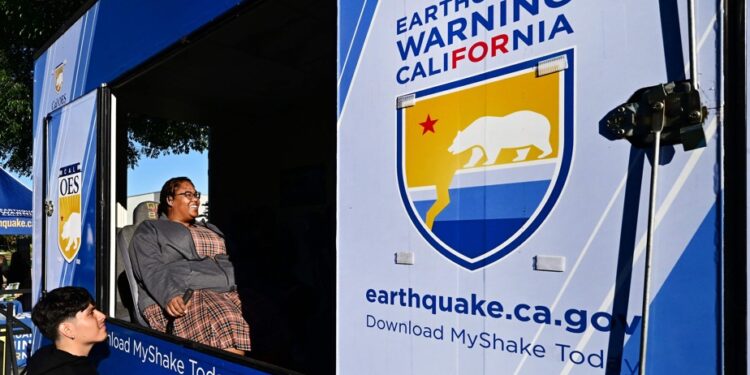(Fullerton) Clinging to his seat in a simulator, Randy Baxter tries to withstand the tremors of a major earthquake. But the convulsions are so violent that they send his legs flying into the air.
“It was much stronger than I imagined,” smiles the 62-year-old professor, getting out of this prevention truck, on the campus of the University of California in Fullerton, near Los Angeles.
Once a year, the machine makes a week-long tour to raise awareness among thousands of Californians, replicating the effects of a magnitude 7 earthquake.
Or the power of the famous “Big One”, which could cause 1,800 deaths, 53,000 injuries and 200 billion dollars in material damage, according to projections from the American Institute of Geophysics (USGS).
“It’s crazy. (…) If we try to get up, we will be thrown across the room and hurt ourselves. So it’s almost better to just hang on,” notes Mr. Baxter, although he is used to feeling earthquakes of average intensity.
“Lower yourself, protect yourself, hold on”: the slogan is hammered out on the leaflets distributed by the organizers. Because in this American state with more than 500 active seismic faults, not everyone has the right reflexes.
“If you’re running out of your house and a tree falls on you, it probably wasn’t a good decision,” says Jon Gudel, an employee with the California Office of Emergency Services (CAL OES).
Disaster guaranteed
In the event of an earthquake, “try to find something solid, preferably a table, crawl under it, cover your head and neck, and then hold on to that table until the shaking stops,” including aftershocks, he insists.
Perched on the boundary between the Pacific and North American tectonic plates, California experiences thousands of earthquakes each year, most of them too weak to be felt. Although it is impossible to predict when the next disaster will occur, it is nonetheless guaranteed.
“That’s why it’s important to be prepared,” continues Mr. Gudel.
In the truck, shocking photos recall the disasters suffered by the “Golden State”, from the great San Francisco earthquake, which destroyed 80% of the city in 1906, to the Northridge earthquake in 1994, which left 72 dead in Los Angeles and caused the collapse of several elevated highways.
Enough to dampen the enthusiasm of certain students believing they were in a mini-amusement park.
When they get out of the vehicle, professionals remind them of the importance of having a bag dedicated to emergencies, with clothes, medicines, a first aid kit and some cash.
More frequent earthquakes
These recommendations resonate all the more strongly because in the last two years, several earthquakes with a magnitude greater than 4 have played on the nerves of Californians.
Andrea Okoh, who lives along the famous San Andreas Fault, a land scar stretching nearly 1,300 kilometers in the state, admits to being “extremely worried”.
At 36, this human resources director has fixed her furniture to the wall since an earthquake woke her up in the middle of the night in January. She fears that the increased frequency of tremors could signal impending disaster.
“If the pressure is escaping more and more, it’s obvious that it’s because there is something that needs to come out,” she fears.
But in her kiosk where she explains plate tectonics with a model, Ashleigh Kuiroz reassures.
“A small earthquake does not mean that a bigger one will happen,” summarizes this geology student. The recent earthquakes, on the other hand, are “an excellent reminder to perhaps think about preparing a survival kit”.
Organizers also recommend that residents, and even tourists, install the “MyShake” application, which can send an alert a few moments before the tremors spread.
“This is important, because you could gain vital seconds,” emphasizes Mr. Gudel.



